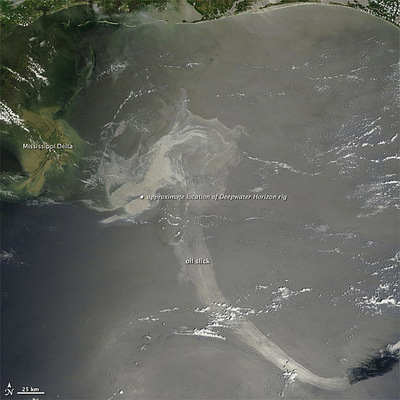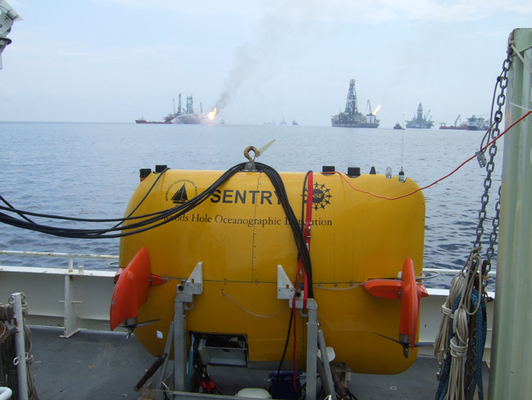
by Carolyn Gramling Thursday, January 5, 2012

The oil spill in late May 2010. NASA

The autonomous underwater vehicle Sentry tracked the oil plume in the Gulf of Mexico. Dana Yoerger, Woods Hole Oceanographic Institution
There is definitely a deep plume of oil in the Gulf of Mexico, and it was definitely produced by BP’s damaged Macondo well, according to a report published today in Science. Scientists from the Woods Hole Oceanographic Institution (WHOI) in Massachusetts reported unequivocal evidence of a plume at a depth of about 1,100 meters that was at least 35 kilometers long, as of the end of June. The plume, they said, was traveling to the southwest, largely driven by the topography of the seafloor. They also found — contrary to some other studies — that microbes do not appear to be significantly munching on the oil in this deep plume.
This is interesting on multiple levels: Since the April explosion on the Deepwater Horizon’s drilling rig triggered a leak in the Macondo oil well, it has been unclear whether the leaked oil would mostly be buoyant enough to rise to the surface ocean or whether any significant fraction would remain in the deeper waters. In short, this finding answers one — OK, two — big questions: 1) There’s a deep plume; and 2) it’s definitely from the Macondo well rather than from natural seeps. That last point comes from the concentrations of four volatile organic compounds in the study’s water samples — specifically benzene, toluene, ethylbenzene and total xylenes, called “BTEX” for short, which are commonly found associated with petroleum. These hydrocarbons were being added to the Gulf at rates of 5,500 kilograms per day — more than double the rate of inputs for these hydrocarbons from all natural seeps in the northern Gulf of Mexico.
So that’s one important question answered. But as the researchers themselves noted, there are many, many others remaining: How will microbes interact with the oil? What about the chemical dispersants? Are gas hydrates going to form, since the plume is so deep?
There is only limited data on the microbe question so far. The study cites concentrations of dissolved oxygen in the plume; oxygen drawdown in water samples is a common way to estimate the activity of microbes. But the dissolved oxygen numbers were not much different from background levels — and why that was the case is still unclear. Microbes want to eat oil — it’s like “butter” to them, WHOI geochemist Chris Reddy noted at a press conference Thursday. But they are, in a way, like teenagers, he added: They do what they want, when they want. The oil might be expected to represent a big feast for them, but at those depths and resulting colder temperatures, it’s not clear what activity could be expected (as a very general rule, microbes are less active at colder temperatures).
The simple truth is, there’s just not much data on this sort of thing. Scientists have had little opportunity to study the fate of oil in a deep plume in the environment. The closest they came was a study in which researchers “leaked” oil and gas for two hours into 800-meter-deep waters off Norway. That study found evidence of a deep oil plume trapped in the subsurface — but as the WHOI team’s lead scientist Richard Camilli noted, that brief duration never allowed the oil enough time to reach steady-state, so scientists couldn’t really see how it behaved.
The Macondo well, Camilli noted, was also considerably deeper, which could provide more opportunity for subsurface plumes to form. But “we don’t know the process, so it’s difficult to model,” he said. Pressures and temperatures at 1,100 meters depth can cause the hydrocarbons to behave differently chemically than at surface — some light hydrocarbons that are normally gaseous may be liquid in those conditions, for example. And 1,100 meters is below the gas hydrate stability zone as well; how hydrates, as well as chemical dispersants, may have all played a role in plume formation is still unclear.
The WHOI team is still investigating these questions — analyzing the samples for additional hydrocarbons, particularly semi-volatiles, will take many more months and is necessary to understand the full volume of the plume, Reddy said. All of these questions, however, represent not only a significant question mark in the ongoing disaster, but also an unprecedented scientific opportunity, incorporating both the next-generation of autonomous underwater vehicles (the AUV Sentry tracked the plume by first sensing its presence with chemical sensors, then zigzagging in swaths to map its extent). And the WHOI team was only out there for about nine days — their trip was cut short by the arrival of Hurricane Alex, which also prevented them from seeing how far from the well the deep plume really extended. So where the plume is now is also a big question mark.
How much oil is still out there, at depth or on the surface, is also still a point of contention. In early August, White House officials announced that 75 percent of the oil spilled from the leaking (now capped) Macondo well is already gone. The WHOI scientists said decisively that they wouldn’t comment on the White House’s statement. “At this point, what we know is that a [deep] plume exists,” Reddy said.
But other scientists have challenged the White House’s announcement. On Thursday, NOAA senior scientist Bill Lehr testified before a House Energy and Commerce subpanel that the report earlier this month was released prematurely by the White House — although NOAA had been preparing the report, it was still in peer review, Lehr said, and the data backing up the White House’s assertions were not yet available. He also noted that contrary to the report’s claim that three-quarters of the oil is gone, federal officials have only confirmed that about 10 percent of the 4.1 million barrels that leaked into the Gulf are gone due to skimming or burning.
© 2008-2021. All rights reserved. Any copying, redistribution or retransmission of any of the contents of this service without the expressed written permission of the American Geosciences Institute is expressly prohibited. Click here for all copyright requests.